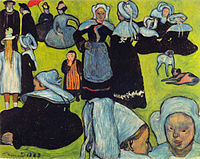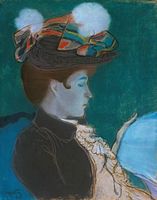Cloisonnism
Albright-Knox Art Gallery, Buffalo, New York
Cloisonnism is a style of
fired. Many of the same painters also described their works as Synthetism
, a closely related movement.
In The Yellow Christ (1889), often cited as a quintessential cloisonnist work[by whom?], Gauguin reduced the image to areas of single colors separated by heavy black outlines. In such works he paid little attention to classical perspective and eliminated subtle gradations of color—two of the most characteristic principles of post-Renaissance painting.
The cloisonnist separation of colors reflects an appreciation for discontinuity that is characteristic of Modernism.[2]
Gallery
-
Émile BernardSelf-portrait with portrait of Gauguin, dedicated to Vincent van Gogh. Bernard, 1888
-
Émile Bernard, Breton Women in the Meadow, August 1888.
-
Vision after the Sermon, 1888.
-
Louis Anquetin, Reading Woman, 1890
Resources
Notes
- ^ Dujardin, Édouard: Aux XX et aux Indépendants: le Cloisonismé (sic!), Revue indépendante, Paris, March 1888, pp. 487-492
- ^ Review by William R. Everdell of The First Moderns, Profiles in the Origin of Twentieth-Century Thought University of Chicago Press, 1997 retrieved March 27, 2010





